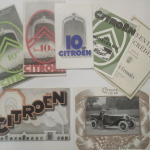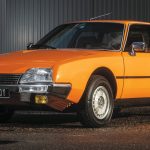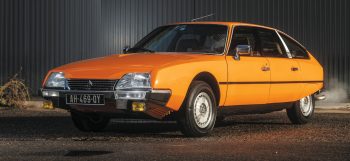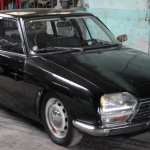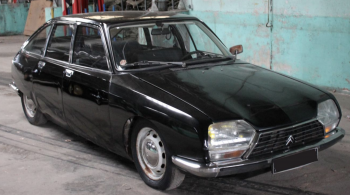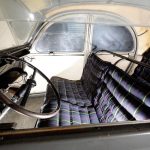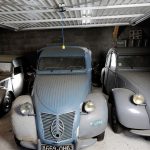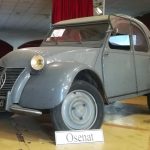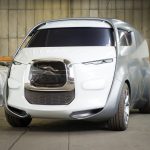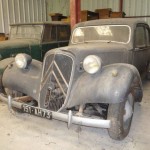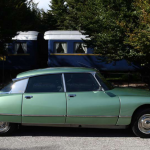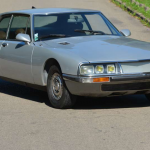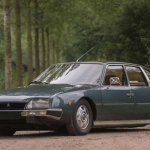Die Gerüchte kursierten bereits im letzten Jahr und wurden intensiv auf der Retromobile 2012 in Paris diskutiert. Und dann ist es passiert. Die Firmengruppe “HEULIEZ SAS” hat beschlossen, einen Teil der unternehmenseigenen Sammlung von Prototypen, Designstudien und Modellen zu veräußern. Artcurial, bekannt für die Versteigerungen aussergewöhnlicher Automobile, wird im im Rahmen der Le Mans Classic am 7. Juli 2012 um 18Uhr insgesamt 41 außergewöhnliche Fahrzeuge veräußern, sowie am Sonntag, den 7. Oktober 2012 ab voraussichtlich 14h30 auf dem Werksgelände von Heuliez in Cerizay (79).
(Vorbesichtigung möglich ab 6.10.2012, 14-18h und 7.10.2012, 9-12h).
Das in einer wirtschaftliche Krise steckende Unternehmen sieht sich zu diesem aussergewöhnlichen – und für Fans der Marke sicherlich schockierenden – Schritt entschlossen. Ein großer Teil der Geschichte von Heuliez, bislang versammelt im “Conservatoire Heuliez”, wird in seiner Einheit und Gesamtheit zerbrochen werden. Bemühungen, dieses einzigartige Firmenerbe zu erhalten, sind leider bislang zum Scheitern verurteilt gewesen.
François de Gaillard, Leiter der Heuliez-Unternehmensgruppe, hatte angekündigt, sich vom Bau von Fahrzeugen zu trennen und seine Kernkompetenz im Bereich der industriellen Zulieferung zu etablieren. Damit stand weitaus mehr zur Disposition, nämlich insbesondere der Verkauf von rund 750 Patenten im Automobilbau, darunter für Faltdächer, wie sie im Peugeot 206 CC verwendet wurden. Der Know-How-Transfer zu den Lizenznehmern bzw. Nacherwerbern wurde vertraglich gesichert.
Viele Citroën wurden bei Heuliez gebaut, darunter in Großserie Modelle wie der Citroën BX Break (1985–1994), Citroën CX Break (1989–1991), Citroën XM Break (1992–2000) und der Citroën Xantia Break (1995–2001). In Kleinserie entstanden der Citroën Visa Chrono (1984), Citroën Visa Mille Pistes (1984), Citroën Visa Cabriolet (1984) und Citroën BX 4TC (1986). Peugeot liess die Modelle Peugeot 206 CC (2000–2007) und Peugeot 604 Limousine (1978–1984) bauen, Opel den Tigra Twin Top (2004–2009). Auch für den Personentransport sind in der Kooperation zwischen Citroën und Heuliez viele Busse von Heuliez karosseriert worden.
Doch zurück zu den zur Versteigerung anstehenden Automobilen. Viele der nunmehr zum Verkauf anstehenden Designstudien wurden realisiert, ohne jemals in eine Serienproduktion überführt worden zu sein. Es sind daher einzigartige Prototypen aus Blech, Lehm und Laminaten, die den Ideenreichtum und die geschichtliche Entwicklung der Design-Büros von Heuliez wie ein Geschichtsbuch dokumentieren, und die in ihrer Einheit nun auseinander gerissen werden, insbesondere da sich keine wirtschaftliche Basis für die Etablierung eines Museums finden ließ.
- Citroën M35 (1970)
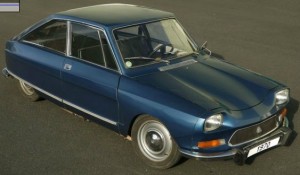
Das persönliche Automobil von Firmengründer Henri Heuliez, Châssis N° 00EA0039 und eigens für ihn in in der Heuliez-Unternehmensfarbe blau umlackiert (alle anderen M35 blieben offiziell grau),
Der Wagen wurde von Heuliez im Alltag bewegt und hat daher einen Kilometerstand von 87.059km sowie eine “carte grise”.
Der Schätzpreis liegt bei ca. 20.000-40.000 Euro.
- Citroen ZX “Vent d’Ouest” (“West Wind”) (1994)
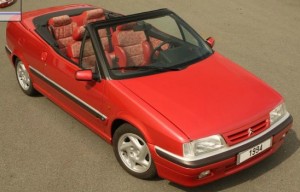
Der ZX wird geplant als Modell zwischen dem kleinen AX und dem mittlererweile gereiften BX. Beide Karosserieformen des ZX, eine 5-türige Limousine und ein 3-türiges Coupé, waren entwickelt, um eine jüngere Klientel zu adressieren. Dieser Logik folgend war das Cabriolet die attraktive Ergänzung des ansonsten eher bodenständiges Modell.
Im März 1994 begann Heuliez, auf Basis des ZX Coupé eine 4-sitzige Studie in Zusammenarbeit mit Citroën und ASC entwickelt. Das Heck wurde um rund 13cm verlängert und der Kofferraum bot trotz des unterzubringenden Faltdachs mehr Platz als das Coupé. und im Oktober 1994 auf dem Pariser Automobilsalon präsentiert. Aber das Peugeot 306 Cabrio ist bereits lanciert, und PSA wollte keine Konkurrenz aus dem eigenen Konzern präsentieren. Zudem war der ZX schon im vierten Jahr am Markt, und die Entwicklung des Xsara war bereits im vollen Gang. Das AUto hat 12km auf dem Tacho und bleibt ein Einzelstück. Schätzpreis ca. 20.000-40.000 Euro.
- Citroen AX Evasion (1988)

Heuliez entwirft 1988 eine Kombiversion des AX, dessen Radstand um 23cm verlängert wurde. Das von aussen eher unscheinbar klein wirkende Modell bietet innen erhöhten Sitzkomfort auf bis zu 7 Sitzen in drei Reihen. Als Zielgruppe waren Mütter avisiert, die ihre Kinder zur Schule bringen. Das Fahrzeug war asymmetrisch ausgelegt: 2 Türen auf der Beifahrer-Seite, aber nur eine Tür auf der Fahrerseite. Der Innenraum war – wie beim Sondermodell “Woolmark” BX Kombi – mit Applikationen aus der Kooperation mit dem englischen Modehersteller gestaltet. Ein Webasto-Schiebedach ergänzte die funktionell-attraktive Präsentation.
1993 erhält das Modell eine neue Lackierung für eine Citroën-Präsentation, aber nicht zum Serienmodell weiterentwickelt. Eitgentlich gilt dieses Modell als Heuliez-Interpretation des erst 8 Jahre später aufgelegten Citroën Berlingo. Schätzpreis ca. 6.000-10.000 Euro.
- 1988 Citroën BX BREAK 19 TRD “Surélevé”
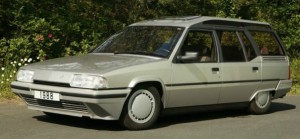
Heuliez beschäftigte sich neben der Serienproduktion von BX Kombi Modellen auch mit neuen Varianten dieses Modells, welches dann Citroën vorgestellt wurden. Im Jahr 1988 wurde dieses einzigartige Sondermodell in einer internen Präsentation den Direktoren von Citroën vorgestellt, aber nie der Öffentlichkeit präsentiert.
Auch hier werden die dem Berlingo später zugrundeliegenden Design-Prinzipien eines deutlich geräumigeren und zugleich durch die vergrößerten Fensterflächen helleren Innenraums umgesetzt. Die hinteren Türen, die Karosserieform und der Heckabschluß wurden eigens entwickelt.
Das in graumetallic ausgeführte Studie wurde ebenfalls in “Woolmark” Wolle und Chamois ausgeführt. Der 1.9L 4-Zylinder TRD Diesel mit 5-Gang-Getriebe war nicht lang in Betrieb – der Wagen hat nur 20km auf dem Tacho und blieb ohne Strassenzulassung. Er wird zwischen 10.000 und 15.000 € geschätzt.
- Citroen BX Dyana (1986)

Der BX erschien erstmals im September 1982 und war das erste Auto, die Marke Citroën nach der Übernahme durch Peugeot und Integration in die PSA-Gruppe zu repräsentieren. Das BX-Projekt sah allerdings keinen Kombi vor, da die Finanzlage von Citroën alles andere als gut aussah. Heuliez war es, die dem Management in Neuilly die ansprechend konzipierten und kostengünstige Kombi-Version zu beeinflussen. Bei dem von Heuliez vorgeschlagenen Konzept wurden die wesentlichen Strukturelemente der Limousine übernommen, wie beispielsweie den gleichen Radstand, die gleichen hinteren Türen und C-Säule, um Mehrkosten gering zu halten. Der Überhang wurde um 16cm verlängert und das Dach wurde um 7cm angehoben, um einen geräumigeren Innenraum zu schaffen.
Der Erfolg der BX Limousine führte dazu, dass die Fabrik in Rennes-La-Jannais voll ausgelastet und nicht in der Lage war, die Produktion zu steigern bzw. den Kombi herzustellen. Heuliez unternahm erhebliche Anstrengungen, den klassischen Standort Cerizay auszubauen und neben der Entwicklung vo Karosserieformen nun auch eine Produktionslinie bereitzustellen. Der BX Kombi bekam die Modellbezeichnung “Evasion”, die von Heuliez bereits für eine luxuriösere CX-Kombi-Studie verwendet wurde. Heuliez produzierte insgesamt 186.827 BX zwischen 1985 und 1994 in Cerizay.
Auf der Paris Motor Show im Oktober 1986 enthüllte Heuliez die Studie “BX Evasion Dyana” auf Basis des Evasion GTI Break. Dieser griff Design-Ideen der sportlich gestylten Konkurrenz von Lancia Beta HPE und Volvo P1800 ES auf. Ein eleganteres Design profitiert hier von den verlängerten vorderen Türen. Der besondere Charme entsteht aus dem Versuch, die Unterbrechung der seitlichen Linienführung durch einen matt schwarzen Streifen zu cachieren. Auf dem Dach wurden die Reling entfernt und ein Webasto-Schiebedach von Heuliez eingesetzt. Eine weitere Besonderheit war die breitere, niedrigere Verkleidung an den Seiten und die Stoßfänger, die nun mit dem Karosseriebauer-Emblem gekennzeichnet sind. Das Fahrzeug besitzt Leichtmetallfelgen und hervorragende schwarze Lederausstattung. Es wird von einem Vierzylinder-Benzinmotor angetrieben und besitzt ein manuelles Fünfgang-Getriebe. Laufleistung ist nur sagenhafte 35 km. Das Fahrzeug mit der Châssis Nr. “HZ1986-2” wurde nie offiziell zugelassen. Citroën-Enthusiasten schätzen die einzigartige und historische Bedeutung dieser Schöpfung, die zu Hause in keiner Sammlung des doppelten Chevron-Marke wäre.
- Citroen XM Palace (1992)
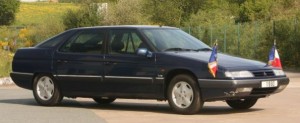
Präsentiert in Genf im Jahr 1992, ist der Radstand des XM um 13cm und der hintere Überhang um 20cm verlängert. Es bleibt ein einzigartiges Modell, wurde neu überarbeitet im Jahr 1995 und dann metallic blau lackiert. Es ist für den offiziellen Besuch von Präsident Chirac bei Heuliez am 15. Januar 1996 verwendet worden. Schätzpreis zwischen 15.000 und 20.000 €.
- Citroën BX 4TC (1986)
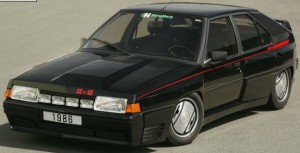
Heuliez war mit dem BX und seinen Konstruktionselementen so gut vertraut, daß er den BX als Rennfahrzeug für die neue Rallye-Klasse “Gruppe B” vorschlug.
Die Regeln für die Zulassung eines Fahrzeugs besagen, daß zumindest 200 Fahrzeuge in Serie dazu als Basismodell gebaut werden müssen. PSA gab dem BX den Vorzug, die “Marke unterm Doppelwinkel” zu repräsentieren (der Peugeot 205 wurde als T16 realisiert). Ein verkürzter Radstand mit Vierradantrieb war Basis des BX4TC. Angetrieben von einem längs eingebauten 2.141ccm Aggregat und Garrett T3 Turbolader, erreicht der BX4TC rund 220km/h bzw. 200 DIN-PS bei 5.250 U/min. Der Motor stammt aus dem Peugeot 505 Turbo Injection, dieser wiederum aus der Kooperation mit Chrysler.
Der BX4TC wurde auf einer eigenen Produktionslinie in Cerizay von Hand hergestellt und ausschließlich in weiss ausgeliefert. Aus dieser Normalversion wurden weniger als ein Dutzend Rallye-Modelle für die Gruppe-B-Rallye vorbereitet, als Zweitürer und mit verkürztem Radstand.
Leider war der BX4TC nicht in der Lage, sich von der Konkurrenz abzusetzen, und nachdem in der PSA Gruppe auch noch das Geld für den Peugeot 205 T16 aufzuwenden war, wurde die Karriere des BX4TC drei Jahre später und nach 85 produzierten Fahrzeugen im Jahr 1988 beendet.
Citroën versuchte, die Fahrzeuge zurückzukaufen, um den erhöhten Aufwand bei Instandsetzung und Wartung zu umgehen. Die nicht verkauften oder zurückgekauften Exemplare wurden vor den Augen eines Notars zerstört. Rund 40 Exemplare des BX4TC haben dennoch überlebt. Der BX4TC gilt immer noch als der Urahn des Rallysports, wie wir ihn heute kennen und der bislang zu 7 Rallye-Weltmeistertiteln führte.
Das nunmehr versteigerte Exemplar stammt aus der Lehrlingswerkstatt des “Lycée Professionnel de Niort”. Es wurde vom damaligen Heuliez-Chef Gérard Quéveau in schwarz bestellt und ist damit der einzig legitim nicht-weisse BX4TC.
Der Wagen mit Châssis n° HZ1986-3 hat nur 1.036km auf dem Tacho. Schätzpreis rund 20.000 bis 40.000 Euro.
- 1971 Citroën SM “Espace”
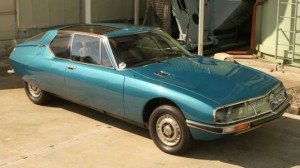
Heuliez nahm sich auch des 1970 auf dem Genfer Automobilsalon erstmalig vorgestellten Citroën SM an, und entwickelte eine Art “Hybrid” zwischen einem Coupé und einem Cabriolet: den “SM Espace”. Der Wagen erhielt zwei besondere Dachausschnitte in Höhe der Türen, bei dem elektrisch sparat einfahrbare Lamellen montiert waren, die in einen verbliebenen Mittelsteg zurückbewegt werden konnten, und so ein “targa-ähnliches” Fahrerlebnis ermöglichten. Von diesem Fahrzeug gab es zunächst ein Exemplar, welches auf der 1971 Automobilausstellung in Paris mit einer Heckjalousie präsentiert wurde. 1972 wurde ein zweites Modell gebaut für Henri Heuliez und in seiner FIrmenwagenfarbe blau lackiert, und gilt somit als einzig existierender authentischer Citroën SM Espace, nachdem das erste Exemplar offiziell bei Heuliez zerstört wurde.
Der Wagen mit der Chassis n° 00SB6200 erhielt den besonderen Status des “l’Inventaire supplémentaire des Monuments Historiques” als nationales historisches Kulturgut und der Erlös in dieser Versteigerung wird bei 200.000 bis 400.000 Euro erwartet.
- Citroën XM “Limousine” (1995)
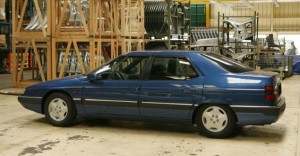
Heuliez schuf mit dem Chassis n°HZ1996-1 einen weiteren Entwurf für eine XM “Limousine” auf Basis des bereits in Cerizay hergestellten XM Break (Kombi). Die Limousine war allerdings keine echte: zum einen ist sie nur als 2-Türer ausgelegt, und zum zweiten ist das Heck komplett aus Ton geformt und damit kein echt strassentaugliches Modell (ohnehin fehlt der Motor). Das Modell wurde 1996 beim Besuch der Heuliez-Werke des französischen Staatspräsidenten Chirac präsentiert. Schätzpreis: 2.000-4.000 Euro.
- Citroën Xantia Break 4×4 “Buffalo” (1996)

Mit dem vom BX 4×4 erworbenen Wissen und dem des bereits in den eigenen Fabrikhallen hergestellten Citroën Xantia Kombi entwickelte Heuliez den “Xantia 4×4 Buffalo Break”. Das englische Unternehmen “FFD-Ricardo” steuerte den 4-Rad-Antrieb bei.
Das “Buffalo” bezieht sich insbesondere auf die elegante Innenausstattung mit rotem Büffelleder und Cashmere. Leider blieb der mit einem 5-Gang-Getriebe ausgestattete 4-Zylinder 12-Ventiler Diesel nur für Showzwecke sichtbar – er hat nur 2km auf dem Tacho. Schätzpreis ca. 15.000-25.000 Euro.
- Citroën Concept Car “Scarabée d’Or” (1990)

Der im März 1990 auf dem Genfer Automobilsalon vorgestellte Citroën Scarabée d’Or ist ein reiner Versuchsträger und verfügt leider weder über Motorisierung noch Steuerung.
Sein Name referenziert auf die berühmten Citroën Autochenilles der Croisière Noire von 1922, und war als 4×4 für flexiblen Einsatz für Sport und Outdoor konzipiert.
Schätzpreis ca. 10 000 – 15 000 Euro.
- Citroën VLH M7 4×4 (1971)

Der M7 stammt aus einer Zeit, als Citroën für eine Ausschreibung der französischen Armee 1970 ein leichtes und geländetaugliches Fahrzeug als Konkurrenz zum Willys Jeep anbieten wollte. Vier vollausgerüstete Soldaten nebst Funkanlage soltlen transportiert werden können, sowie auch vom Helikopter aufzunehmen sein und per Fallschirm abwerfbar.
Das tatsächlich hydropneumatisch ausgelegte Fahrwerk und mechanische Komponenten stammen vom GS. Das doch eher funktionelle Design entstand unter Federführung von Jacques Cooper, der auch für das Design des französischen Schnellzugs TGV verantwortlich zeichnete.
Nach ersten Prototyp-Entwürfen entstand ein weiterer Prototyp mit nunmehr für den Helikoptertransport umklappbarer Frontscheibe, vier Türen, und einem kompletten Restyling. Der Tacho stammt vom Ami8. Der Wagen wurde den Behörden vorgestellt und bekam die Zulassung für erste Outdoor-Tests.
Doch leider kam das Aus für den Citroën M7 aus verschiedenen Gründen. Zum einen wollte die finanziell unter starkem Druck leidende Peugeot nicht die besondere Technologie der hydropneumatischen Fahrwerksaufhängung weiter verfolgen. Zum zweiten war auch die im Vergleich zur konventionellen Federung aufwendigere Hydropneumatik nur von Fachleuten fachgerecht in Stand zu setzen. Daher wurde das Projekt vom Verteidigungsministrerium in Paris wieder eingestellt. Dennoch war die hier entstandene Arbeit die Grundlage für die spätere Kooperation von Peugeot mit Mercedes, als die französische Armee dann das G-Modell mit Peugeot Diesel-Reihenvierzylinder erhielt und in größeren Stückzahlen auslieferte. Der Prototyp hat nur 358km auf dem Tacho. Schätzpreis: 8 000 – 16 000 Euro.
Soweit Auszüge aus der Versteigerungsliste. Viele attraktive Modelle und Einzelstücke werden angeboten und sicherlich viele davon in Einzelsammlungen verschwinden. Hoffen wir, daß dem “Conservatoire Citroën” nicht bald das gleiche Schicksal droht…!
The rumors were circulating last year and were discussed at the Retromobile 2012 in Paris. And then it happened. The group “HEULIEZ SAS” has decided to sell part of the company’s own collection of prototypes, design studies and models. Artcurial, known for its auction of exceptional cars, is going to sell in the context of the Le Mans Classic on 7 July 2012 at 18h total of 41 unique vehicles, and on Sunday, 7 October 2012 from 14:30 probably on the site of Heuliez Cerizay (79). (Preview available from 06/10/2012, 07/10/2012 and 14-18h, 9-12h).
Being stuck in an economic crisis, some companies look at this extraordinary – and for fans of the brand certainly shocking – decided step. Much of the history of Heuliez which so far gathered in the “Conservatoire Heuliez,” will be broken in its unity and totality. Efforts to preserve this unique heritage companies are unfortunately so far have been doomed to failure.
François de Gaillard, head of the Heuliez Group of Companies, announced to separate itself from the construction of vehicles and to establish its core competence in the field of industrial supply. This was far more at stake, namely, the sale of some 750 patents in the automotive industry, including for folding roofs, as used in the Peugeot 206 CC. The know-how transfer to the licensee or subcontractors was secured by contract.
Many Citroën were built by Heuliez, including high-volume models like the Citroen BX Break (1985-1994), Citroen CX Break (1989-1991), Citroen XM Break (1992-2000) and the Citroen Xantia Break (1995-2001). In small series Heuliez created the Citroën Visa Chrono (1984), Citroen Visa Mille Pistes (1984), Citroen Visa Convertible (1984) and Citroën BX 4TC (1986). Peugeot models such as the Peugeot 206 CC (2000-2007) and Peugeot 604 Sedan (1978-1984) were built, as well as the Opel Tigra Twin Top (2004-2009). Also for public transportation, many buses were built and coachworks was performed by Heuliez in the cooperation between Citroën and Heuliez.
But back to the upcoming auction of automobiles. Many of the design study is now up for sale have been realized without ever being converted into a series production. There are so unique prototypes from sheet metal, clay, and laminates, which document the wealth of ideas and the historical development of the design offices of Heuliez like a history book, and which in their unit now torn apart, especially since there is no economic basis for the establishment of a Museum.
- Citroën M35 (1970)

During the 1960s, the research department at Citroën worked on licences for cars with a rotary engine developed and patented by the engineer Wankel. A joint venture between Citroën and the German marque NSU was set up under the name Comotor to develop this technology. The first trials took place in the mid-1960s and led to use of a single rotor engine in the production of the NSU-Wankel Spider. Satisfied with these results, Citroën undertook their own reliability trials on a pre-series run. To keep manufacturing costs down, it made sense to use an existing base. Jacques Wolgensinger, in charge of Public Relations, suggested to the head of Citroën, Pierre Bercot, that these trials become part of a marketing campaign, by giving the pre-series vehicles to select VIP clients. It was therefore necessary to create a new model, with a body that distinguished itself from other cars in the range. And thus the Citroën M35 was born, based on the reinforced chassis of an AMI 8, with hydropneumatic suspension from the DS, and featuring a two-door coupé body inspired by the AMI 8. Panel building and assembly was entrusted to Heuliez.
All the M35s were liveried in the same metallic grey, with black imitation leather interior. The level of equipment and comfort was on a par with that of the DS, to satisy the VIP clientele who would have to pay top-of-the-range price for this experimental coupé. Plans were made for 500 examples of the M35 to be built, but just 267 were finished, and handed over to select customers who were treated to a support service from the company. The contract allowed Citroën to buy back the M35s from their ‘trial owners’ at the end of their life to finalise the study of the Wankel engine. The cars that were bought back were stored for a while at the Ferté Vidame test centre before finally being destroyed.
The powerful, high-performance single rotor engine of the M35 provided 49bhp DIN at 5,500 rpm, and mated to a four-speed gearbox, the top speed was 144 km/h. The car’s extraordinary acceleration was achieved with a high level of comfort. A few examples not returned by their owners survived the massacre, including the one offered here, Henri Heuliez’ personal car which was repainted in his trademark colour, metallic blue. Of the M35s that were saved, it is thought that less than 50 examples survive today. The vehicle, with 87,059 km on the odometer, is cosmetically presented in good, used condition, and comes with its carte grise normale. What a rare opportunity this is to buy a running prototype whose previous single owner played a major part in the history of the French automobile.
- Citroen ZX “Vent d’Ouest” (“West Wind”) (1994)

The Citroën ZX was supposed to fit in between the AX and the ageing BX. The two bodies, a five-door saloon and a 3-door coupé, were seen as widening choice to attract a younger clientele. Following this logic, the presence of a cabriolet was seen as the best way to boost the image of this somewhat ordinary model. In March 1994, with the marque’s agreement, Heuliez began designing a four-seater cabriolet, and he presented the prototype at the Paris Motor Show in October 1994, under the delightful name “Vent d’Ouest”.
Using the platform of the coupé, the rear overhang was increased by 13 cm, which gave the “Vent d’Ouest” a larger boot than the standard coupé, despite the space needed for the hood casing. Developed in strict collaboration with ASC, the specialist supplier for cabriolets with electric hoods, the car received an enthusiastic reponse from the public. However, the management at PSA did not want to create competition for its Peugeot 306 cabriolet. Moreover, the ZX range was by then four years old, and the design team were already working on its successor, the Xsara. The “Vent d’Ouest” project had arrived too late ! The elegant ZX convertible therefore remained unique, making it more desirable today.
This running prototype, built on the platform of a ZX that came off the production line, is in superb condition. It has a maroon soft top and an attractive interior with brick red leather and patterned fabric. The car displays just 22 km on the odometer. It is powered by a four-cylinder 16-valve petrol engine mated to a five-speed gearbox. The car has never been registered, but is in running condition, the engine belt has been recently changed. Extremely elegant and finished to a high standard, this superb hand-built concept-cabriolet would have merited production. Today, being unique makes it even more special.
- Citroen AX Evasion (1988)

The Citroën AX, presented in 1986, came just at the right moment to replace the Visa and LNA which had by then enjoyed extended production runs. This small urban car, only available at first with three doors, claimed to be cheap to produce, use and maintain. It was another two years before the range was extended to include the five door version.
It was on this base that Heuliez presented the AX Evasion at the Paris Motor Show in October 1988. With a wheelbase extended by 23cm, the concept car offered a vehicle with raised roof whose increased dimensions allowed room for seven seats in three rows. Petite from the outside, the AX Evasion was roomy inside. The target market for were mothers who drove their children to school and like the AMC Pacer, the car was asymmetrical. With two doors on the right side, or the pavement side, it had just one door on the left side for the driver. It featured a translucent roof at the front. The interior was fitted out in ‘Woolmark’ wool, as Heuliez had continued working with the English firm since the ‘Woolmark’ BX estate. Logically, the AX Evasion Heuliez featured a Webasto-Heuliez “Spoiler roof” sunroof. It was later re-configured as a 1993 model and repainted in metallic green, like it is today, for a presentation to Citroën, which was not followed up. The AX Van Evasion, was a clever proposition dreamt up by Heuliez eight years before the appearance of the Citroën Berlingo.
Offered in very good condition, this vehicle has just 12 km on the odometer. It has a four-cylinder engine and a five speed gearbox. The vehicle has never been registered. Like its predecessors, the AX Van Evasion, a unique concept car, deserves to find its place at the heart of an enthusiast’s collection.
- 1988 Citroën BX BREAK 19 TRD “Surélevé”

Given the task by Citroën of producing the BX Evasion estate series, Heuliez tried out variations on this theme, which he proposed to the manufacturer. This raised estate car was shown to the director of Citroën at a special presentation in 1988, but was never seen by the public. The project was not taken up by the marque and this concept car will remain unique.
Unlike the production estate model which featured the rear doors of the saloon, this estate was based on a design which allowed for a much roomier interior. The rear doors, the superstructure and the tailgate are unique to this handbuilt prototype. The raised roof allowed taller windows which give the cockpit more light.
This concept car, finished in metallic grey has 7/8 seats. It is in excellent condition, as is the interior which is presented in a mix of Woolmark wool and chamois. Fitted with a 1.9-litre 4 cylinder TRD diesel engine, it has a five-speed gearbox. The odometer reads just 20 km and it has never been registered. This is a very rare opportunity for a collector of this marque to acquire a unique concept car in superb condition. The car is destined to find its place in the collection of a knowledgable Citroëniste !
- Citroen BX Dyana (1986)

The BX first appeared in September 1982 and was the first car to represent Citroën’s revival after its takeover by Peugeot and assimilation into the PSA brand. However the BX project made no mention of an estate version, as the marque finances were very much the same colour as the newly launched BX : red. It was left to the coachbuilder Heuliez to influence the management at Neuilly by producing a clever and inexpensive estate version. The concept proposed by Heuliez was designed to keep the main structural elements of the saloon, and therefore be economical to build. It had the same wheelbase, and used the same rear doors and rear pillar. An overhang at the back added 16cm to the length and the roof was raised by 7cm to create a roomier interior. The base was adapted to cope with the new design, employing upgraded suspension.
The directors at Citroën were won over by this proposition, which also offered a second, cheaper body. There was one major problem to overcome however : production. The success of the BX saloon meant that the factory at Rennes-la-Jannais was at full capacity and unable to increase production. Heuliez, therefore, invested in the historic site at Cerizay, adding a modern production line, and transforming the company from coachwork designer to coachwork manufacturer. The BX Estate took the name Evasion, which had already been used by Heuliez for an extended luxury version of the CX estate. This first large-scale series produced by Heuliez marked the start of a fruitful collaboration with Citroën, and some 186,827 examples of the BX Evasion rolled off the production line between 1985 and 1994. Subsequently, it became easier for the team at Cerizay to develop particular variations of their original creations.
At the Paris Motor Show in October 1986, Heuliez unveiled the Evasion Dyana estate, taken from the Evasion GTI estate. This took up the idea of the sporting estate already seen on the Lancia Beta HPE and the Volvo P1800 ES. The car boasted a more elegant design with elongated front doors. Its charm comes from the attempt to conceal the rear quarter panel upright between the door and the boot, with a matt black striated strip to disguise the interruption to the line. Also, the roof lost its utilitarian roof bars and was replaced with a Webasto-Heuliez sunroof. Another distinctive feature was the wider, lower trim on the sides of the car and the bumpers which featured the coachbuilder’s emblem.
This unique model is cosmetically in wonderful condition and it has been restarted by the Heuliez team and is in running condition. It has alloy wheels and superb black leather interior. It is powered by a four-cylinder petrol engine twinned to a manual five-speed gearbox. The odometer reads just 35 km. The vehicle has never been registered. Citroën enthusiasts will appreciate the unique and historic importance of this creation which would be at home in any collection of the double chevron marque.
- Citroen XM Palace (1992)

When Citroën presented the top-of-the-range XM in 1989, to replace the ageing CX, there was no estate car in the catalogue and it was 1991 before this version made its appearance. The task of designing and building the car was given to Heuliez, who was already assembling estate versions of the CX and BX. In fact, the coachbuilder from Deux-Sèvres was completely familiar with the platform and had all the necessary equipment. It was therefore straightforward to produce variations that could be produced in small numbers.
That was the case with this first limousine project given the name “Palace”, in reference to the former Pallas versions of the DS and CX. The car, built on the base of a saloon, was presented officially at the Geneva Motor Show in March 1992. The wheelbase had been extended by 13cm, to provide more room for passengers in the rear. It had the classic-shaped boot and rear styling and lights of the saloon, and a more balanced profile than the standard XM, due to a 20cm overhang at the rear.
La XM “Palace” was intended to win over the government, and to infiltrate the ministerial fleet, as well as attract business leaders. As such it would have been the logical successor to the Peugeot 604 limousine and the Renault 25 limousine, both flagship Heuliez models. It didn’t happen and the XM ” Palace ” remained a one-off.
Originally benefitting from a specially styled front end, the XM Palace was reconfigured and repainted in metallic blue in 1995. It served as the official car for the President of the French Republic, Jacques Chirac, when he visited the Heuliez factory on 15 January 1996 to unveil the only production line producing 100% electric cars in the world.
The vehicle has been very well preserved and is in running condition. It sports aluminium-alloy wheels, flag posts on the front wings, black leather interior with wooden trim, anti-theft device, and radio. Under the bonnet, there is a V6 turbo fuel-injection engine with five-speed gearbox.
Exclusive on two counts, this car has the status of a presidential car combined with that of a running prototype. As such it will attract fans of the ‘double chevron’ as well as admirers of great figures in French political history.
- Citroën BX 4TC (1986)

Having enjoyed a good relationship with Citroën since the re-design of the Visa in 1981, Heuliez capitalised on this by proposing an estate version of the BX in 1985. Being familiar with the base model, he was also the logical person for Citroën to turn to when they decided to add a competition version to represent the marque in the new Group B rally class.
The rules laid down for Group B by the international regulatory bodies demanded that manufacturers base competition cars on a production car from the catalogue with at least 200 examples built. Those in charge at PSA chose the BX to represent ‘la marque aux chevrons’. The 205 would be retained in Sochaux to become the 205 T16. A short wheelbase version with four-wheel drive was developed under the name BX 4 TC. It was powered by a 2,141 cc 4-cylinder 8-valve engine boosted by a Garrett T3 supercharger. The official top speed was 220 km/h with 200 bhp Din at 5250 rpm. The engine was borrowed from the Peugeot 505 Turbo injection, which came originally from the Chrysler group. This was placed lengthways at the front unlike the saloon which had a transversal engine, and to accommodate this, the overhang was increased to 1.1m.
Production of the BX 4 TC began at Cerizay in 1985, on a special production line. They were assembled by hand and liveried exclusively in white. From this standard version, less than a dozen cars were prepared with a shortened wheelbase and featuring two doors, to participate in the Group B rallies they had been designed for. The unconvincing performances of the BX 4TC in competition, added to the size of the budget needed to develop the Peugeot 205 T16, and the unforseen demise of Group B, sealed the fate of the BX 4 TC whose career came to an end less than three years later.
Production ceased in 1988 after just 85 cars had been sold. Citroën undertook to buy back some of these cars to avoid having to offer a demanding after-sales service. Cars that were either unsold or bought back were destroyed in front of a legal witness. It is thought that some forty examples of the BX 4 TC survive today. There is no doubt that this extremely rare car represents a milestone in Citroën’s epic involvement in rallying which culminated in seven World Rally Championship titles.
The example offered was handbuilt by bodywork apprentices at the Lycée Professionnel de Niort. It was CEO of Heuliez, Gérard Quéveau, who took the decision, while the car was on the production line, to paint it black so that it would stand out from the rest of the series. The bodywork is in excellent condition. The black velours interior is as new, and the odometer reads just 1,036 km and the car is running.
The story of this car and its ownership make it totally unique and it represents a very rare opportunity to own a piece of rallying history from the late 20th century.
- 1971 Citroën SM “Espace”

The new Citroën SM made a big impression when it was unveiled at the Geneva Motor Show in March 1970. Its unquestionably elegant styling was the creation of the in-house designer, Robert Opron. With a powerful V6 engine, an unrivalled level of comfort due to the hydropneumatic suspension immediately put it ahead of other GT series. Since then, the Citroën SM went on to be honoured as the only French GT 2+2 production car from the 1970s.
Clearly, such a car would not be ignored by coachbuilders. With no convertible entered in the manufacturer’s official catalogue, the coachbuilder Henri Heuliez presented a clever version at the Paris Motor Show in October 1971. Halfway between a coupé and a cabriolet, the car featured a roof which folded away in two sections. This allowed the retention of a central beam which ran lengthways giving the car rigidity and protection if it rolled, as well as the benefits of open-top driving. Each side of the sunroof comprises several panels which disappear into a compartment in the central beam. The whole mechanism is controlled electrically, with each side working independently.
The car is the SM ” Espace “. The first example, built for the 1971 Paris Motor Show, featured special suede upholstery in 1970s shades of white and green, full chrome hub caps and an elegant blind for the rear window. The car received an enthusiastic response from the public. The SM Espace filled the pages of all the specialist magazines of the period : Auto-Journal, l’Automobile Magazine, Action Automobile and Touristique, etc. The same car was shown at the Brussels Motor Show a few months later, this time without its rear blind, and displaying a standard brown leather interior. In 1972, a second example was built for Henri Heuliez’ personal use, and it was painted in his favourite colour, metallic blue. It is this second example which survived, and is today, the only authentic SM Espace. The Motor Show example was officially destroyed, as recorded in the coachbuilder’s files. The SM Espace no.2 was displayed at Retromobile in February 2005.
This car represents perfectly the first stage in the long and fruitful research undertaken by Heuliez to allow production cars to enjoy safe open-top driving. As such, it was recently given an entry in l’Inventaire supplémentaire des Monuments Historiques, confirming its importance in the history of the French automobile.
The car is offered in well preserved, original condition, both mechanically and cosmetically, the car is running and the front and rear spheres have been changed. The interior chamois leather upholstery is in good condition. The V6 2,670cc engine has 3 twin-choke Weber 42 DCNF carburettors which gives the car 170ch DIN at 5500 rpm. This SM Espace comes with its original carte grise normale. It is an exceptional car, both historically and technically, and deserves to belong to a true enthusiast of this marque and model, to someone who appreciates how special this car is and will preserve its unique status.
Worthy of a place in the most exclusive concours d’élégance, this incredible GT deserves to be trampling the lawn at the Villa d’Este and braving the salty sea spray at Pebble Beach where its daring and distinction is testimony to the elegance of the last of the great French coachbuilders.
- Citroën XM “Limousine” (1995)

The XM “Limousine” was the second proposition for a top-of-the-range French vehicle, offered to complement the XM “Palace” which had appeared in 1992. This time, the designers at Heuliez-France-Design had decided to use the platform of the XM estate, a car that Heuliez produced for PSA. Despite its name, this wasn’t a true limousine, as it only had two opening doors on each side.
This three box saloon retained the XM boot and lights, but had a more vertical rear window, which provided enough room for a standard boot lid. The rear of the vehicle was modelled in clay to show its size. The model was shown to President Chirac when he visited the Heuliez factory in 1996.
This non-motorised model is presented in good condition, with some cracking to the clay section at the rear. It has no manufacturer’s plate or serial number. The dark grey velours interior is presented in reasonable condition.
This is a fascinating style project of enormous interest to ‘marque aux chevrons’ collectors, who will appreciate its unique and exclusive nature. A gem worthy of a place in the collection of any true citroëniste.
- Citroën Xantia Break 4×4 “Buffalo” (1996)

As he had previously done for the BX and XM, it was Heuliez who planned, developed and produced the estate version of the Citroën Xantia from 1995 onwards. The organisation at Deux-Sèvres produced no less than 147,829 examples up until 2002.
The year after the Xantia estate was presented to the public, in order to show his talents and offer a less standard version, the coachbuilder exhibited the Xantia 4×4 Buffalo estate. It drew from ideas used on the BX 4×4 which had been offered a few years earlier and which hadn’t been as successful as expected. To add a sense of reliability to his project, Heuliez collaborated with the British company FFD-Ricardo to develop the 4-wheel drive transmission.
The exterior styling displayed a flattering and successful mix of elements. The interior, as with previous ” Buffalo ” estates by Heuliez, was finished in an elegant and refined mix of red buffalo leather with and cashmere. The Xantia 4×4 Buffalo remained a one-off creation, as Citroën did not follow up on the idea.
The vehicle is presented in superb condition. It is powered by a four-cylinder 12-valve diesel engine linked to a five speed gearbox. It is fitted with an anti-theft device and has just 2 km on the odometer. The car has never been registered.
Bearing a bold and assertive personality, the Xantia 4×4 Buffalo is bound to appeal to all gentleman drivers of unusual sports cars, and it will add an unorthodox and valuable element to any collection.
- Citroën Concept Car “Scarabée d’Or” (1990)

At the Geneva Motor show in March 1990, Heuliez showed once again the Peugeot Agadès concept car and, alongside it, a second concept car, the Citroën Scarabée d’Or. Whereas the Peugeot Agadès was fully functional, its Citroën alter-ego was just a static model, missing the BX GTI 4×4 engineering intended for it. Taking its name from the Citroën Autochenilles of the Croisière Noire in 1922, the 1990 Scarabée d’Or was a fun micro 4×4 with a flexible use of space. In basic form, the open body came with two front seats, but the boot could be opened out to provide two extra seats. Open to the elements, the semi-open sides allowed a view of the ground while providing a level of protection.
For the record, when it was presented at the Geneva Motor Show, the talented producer Eddy Barclay fell in love with it and signed a blank cheque in an attempt to buy it. This was in vain, however, as Heuliez refused to add the engine without the manufacturer’s permission, which was never granted ! Now you are in a stronger position than the flamboyant Eddy Barclay to become the owner of this fun and friendly concept car.
This model with wheels has neither mechanics nor steering. It is in excellent condition, with functional rear seats. The vehicle has never been registered. An emblem of the incredible creativity of the Heuliez design team, the Scarabée d’Or also epitomizes the numerous attempts made by Citroën to escape its rather classical image. As such, the Scarabée d’Or deserves close attention from enthusiasts who are sure to be captivated by its endearing smile!
- Citroën VLH M7 4×4 (1971)

The M7 project dates from a time when Citroën wished to respond to demand from the armed forces for a light and practical all-terrain vehicle to replace the Willys Jeep. To meet the specification set by of the head of the French army, the vehicle had to be able to carry four soldiers with kit, be fitted with a radio, and above all, be able to be transported by helicopter and parachuted. At the beginning of the 1970s, the three main French car manufacturers were called on by the Ministry of Defence to submit their proposals for such a vehicle.
The coachbuilder Heuliez took the running gear and mechanical components of the GS to begin his development of this 4 x 4. The decision to use hydropneumatic suspension allowed an important degree of off-road driveability. Jacques Cooper, a designer at Heuliez, who would later be involved in designing the TGV, produced several drafts. These included such variations as a four-door roadster and a two-door pick-up. The next phase was to study the running gear. In order to keep the necessary ground clearance, the flat-four cylinder engine of the GS was mounted high up to avoid possible damage while travelling off-road on important missions.
While the project was in its early stages, a visit from the army chief led to important modifications. One of these allowed the windscreen to fold down while being transported by helicopter. Thus a second prototype was developed. This retained four doors, the uprights were reduced and the windscreen was movable. The vehicle was completely re-styled. The foam-covered steering wheel from the GS and the odometer from the Ami 8 were integrated into the dashboard. When the stationary prototype was finished and painted beige, it was shown to the design team next to a standard GS saloon, against a backdrop of sand and rocks. Once the army chief gave his consent, the decision was taken to build a driveable prototype to test the capabilities of the Jeep GS M7. It was the middle of the night a few months later when the wheels of this vehicle turned for the first time in the factory yard at Cerizay. The all-terrain demonstrations were a great success and highlighted the obvious advantages of using hydraulic suspension for this purpose.
However, for different reasons the fate of the Citroën M7 was sealed. On one hand, the Peugeot group, who had just taken over a financially-struggling Citroën, wanted to cut costs and terminate costly projects. Peugeot was not a fan of advanced technology and the hydraulic suspension of the M7 project didn’t persuade them to change this view. On the other hand, the French army also preferred vehicles employing simple technology that was easy to repair. The M7 project was turned down by the Ministry of Defence. Peugeot would draw on the work done, however, as a few years later, a hasty reworking of the all-terrain Mercedes G with Peugeot in-line four cylinder petrol and diesel engines would equip the army in large numbers.
This prototype was kept by Henri Heuliez and was repainted in his favourite colour, metallic blue. It is still in nice original condition as the interior and the softop. The odometer shows 358 km and the car is running with its hydrolical suspension. The car has a French carte grise from the original base, a Citroën GS from November 1971 and a Heuliez chassis number.
This exceptional and unique prototype, for its style as much as its innovative design will seduce all enthusiasts with a passion for advanced and exclusive technology.
So far the list. Lets see how much Citroen enthusiasts will buy – and also who is willing to long-term donate the car to the “Conservatoire Citroën”: maybe it is a good moment to find new ways of cooperation between the brand and it’s enthusiasts? Or do we have to fear the fact that the Citroën collection one day will suffer from the same “sale”?
Update: Auction Results here: http://www.artcurial.com/en/asp/searchresults.asp#a_10394700
